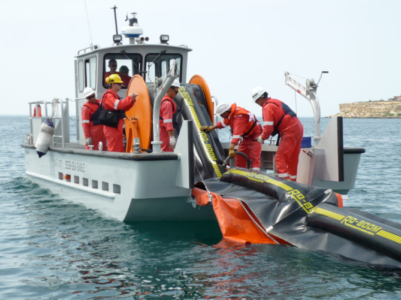From containment booms to beach clean-ups, authorities outline their swift actions to mitigate environmental impact.
SINGAPORE: Nearly 550 tonnes of oil-soaked sand and debris have been collected from Singapore’s beaches following a major oil spill on June 14, caused by a collision between a dredger and a bunker vessel near Pasir Panjang Terminal. While most affected beaches have been cleared, clean-up operations continue at Tanjong and Palawan beaches on Sentosa.
At a press conference on Monday (June 24), Transport Minister Chee Hong Tat provided a detailed timeline of the response efforts, highlighting that the actions taken were in line with international practices for oil spill management.
Timeline of Key Events
June 14
2:22 PM: The Maritime and Port Authority (MPA) was alerted to the collision involving the Netherlands-flagged dredger Vox Maxima and the stationary bunker vessel Marine Honour. Approximately 400 tonnes of oil were spilled into the sea.
2:33 PM: MPA’s first patrol craft arrived on-site and began spraying dispersant to break down the oil and facilitate subsequent clean-up efforts. Eleven additional vessels were deployed for containment and monitoring.
2:55 PM: Salvage provider T&T Salvage Asia was activated to deploy containment booms around the damaged vessel. Preparations to load equipment and dispatch workboats began.
9:20 PM: Sentosa Development Corporation (SDC) cordoned off affected parts of Palawan Beach as oil sheens were observed.
9:41 PM: T&T’s vessel arrived at the incident site.
June 15
5:15 AM: Deployment of 200 meters of containment booms around the damaged vessel was completed despite challenging weather conditions. While the booms helped limit further spillage, tidal currents and waves reduced their effectiveness.
7:00 AM: Oil slicks were detected at Sentosa’s Palawan, Siloso, and Tanjong beaches. Workers were deployed to begin clean-up operations. The National Environment Agency (NEA) also initiated clean-up efforts at East Coast Park, Labrador Nature Reserve, and Tanah Merah beach.
Ongoing Clean-Up Efforts
Grace Fu, Minister for Sustainability and the Environment, announced that the first phase of clean-up operations focused on removing surface oil and contaminated sand and deploying booms to prevent further contamination.
The next phase, expected to take three months, will address harder-to-clean areas such as rock bunds, breakwaters, and oil trapped deeper in the sand. The final phase will involve combing beaches to remove tar balls—coagulated blobs of oil.
Broader Impact
The incident underscores the challenges of managing oil spills in busy maritime hubs. While clean-up efforts have progressed significantly, authorities continue to emphasize the importance of rapid and coordinated responses to mitigate environmental damage.








